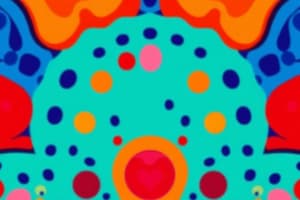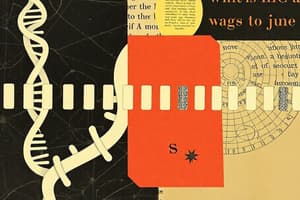Podcast
Questions and Answers
What type of DNA is characterized as circular and found in organelles?
What type of DNA is characterized as circular and found in organelles?
- Nuclear DNA
- Chromosomal DNA
- Mitochondrial RNA
- Cytoplasmic DNA (correct)
Which chromosome type has the centromere positioned exactly in the middle?
Which chromosome type has the centromere positioned exactly in the middle?
- Telocentric
- Subtelocentric
- Metacentric (correct)
- Submetacentric
What is the primary function of chromosomes?
What is the primary function of chromosomes?
- Protein synthesis
- Transmission of genetic information (correct)
- Energy storage
- Regulation of enzymatic activity
Which of the following statements about light bands in chromosomes is true?
Which of the following statements about light bands in chromosomes is true?
How is the arm ratio of a chromosome calculated?
How is the arm ratio of a chromosome calculated?
What distinguishes polytene chromosomes from regular chromosomes?
What distinguishes polytene chromosomes from regular chromosomes?
Where are lamp brush chromosomes primarily found?
Where are lamp brush chromosomes primarily found?
What role does the primary constriction (centromere) play in chromosomes?
What role does the primary constriction (centromere) play in chromosomes?
Flashcards
Nuclear DNA
Nuclear DNA
Found in the nucleus of a cell, organized into linear structures, the primary carriers of genetic information.
Cytoplasmic DNA
Cytoplasmic DNA
Circular DNA molecules found outside the nucleus, in organelles like mitochondria and chloroplasts.
Chromatid
Chromatid
A single, replicated chromosome consisting of two identical sister chromatids joined together.
Centromere
Centromere
Signup and view all the flashcards
Metacentric Chromosome
Metacentric Chromosome
Signup and view all the flashcards
Endomitosis
Endomitosis
Signup and view all the flashcards
Polytene Chromosomes
Polytene Chromosomes
Signup and view all the flashcards
Lampbrush Chromosomes
Lampbrush Chromosomes
Signup and view all the flashcards
Study Notes
DNA Types
- Two main types of DNA: nuclear and cytoplasmic
- Nuclear DNA is linear, found on chromosomes
- Cytoplasmic DNA is circular, found in chloroplasts and mitochondria
Chromosome Structure
- Chromosomes are composed of chromatids
- A secondary constriction on some chromatids, known as a primary constriction (centromere) is present.
- Telomeres are at the ends of chromosomes.
- Chromomeres and chromonemata are also parts of the chromosome structure.
Chromosome Types
- Classified based on the position of the centromere
- Metacentric: Centromere is in the middle
- Submetacentric: Centromere is near the middle
- Acrocentric: Centromere is close to one end
- Telocentric: Centromere is at the end
Function of Chromosomes
- Transfer genetic information from cell to cell and generation to generation
- Release genetic information to perform cellular functions and development
Special Types of Chromosomes
- Polytene Chromosomes: Giant chromosomes
- Lampbrush Chromosomes: Giant chromosomes, found in oocytes of some vertebrates
- Multistranded Chromosomes: Found in salivary glands of Drosophila
- Giant chromosomes can be found in salivary glands or oocytes.
Chromosome Banding
- Dark bands indicate large amounts of DNA, small amounts of RNA, and basic proteins. These bands stain positively with a technique called Giemsa
- Light bands indicate small amounts of DNA, large amounts of RNA and acidic proteins. These bands stain negatively with a Giemsa technique.
Chromosome Behavior During Cell Division
- Somatic cell pairing of chromosomes occurs during cell division.
Studying That Suits You
Use AI to generate personalized quizzes and flashcards to suit your learning preferences.




